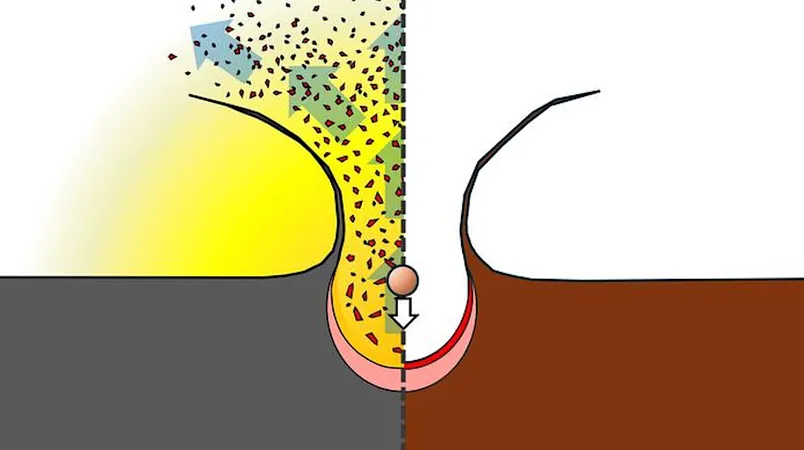
Revolutionary Method Detects Antibiotic Residues in Meat: What You Need to Know!
2025-04-14
Author: Arjun
Meat is a staple in diets globally, but what's lurking beneath the surface? Recent findings reveal that harmful antibiotic residues could endanger unsuspecting consumers.
A Breakthrough in Detection Technology
Researchers have developed an innovative smartphone-assisted method to swiftly detect these residues before they end up on dinner plates. This technique employs a specialized probe that changes color when it comes into contact with specific antibiotics, offering a quick and straightforward alternative to traditional laboratory testing.
Why Detecting Antibiotic Residue Matters
As concerns mount over the overuse of antibiotics like ciprofloxacin in livestock, the need for efficient detection methods has never been clearer. This synthetic antibiotic, often prescribed for infections, can lead to the emergence of resistant bacteria, posing a significant public health risk. The World Health Organization has raised alarms about this escalating issue, emphasizing the immediate necessity for vigilance in antibiotic practices.
Health Risks Linked to Antibiotic Overuse
When bacteria adapt to antibiotics, they evolve into formidable foes, making infections harder to treat. The public health implications are grave, threatening effective disease management and control.
Government Oversight is Intensifying
The U.S. Food and Drug Administration (FDA) is keenly monitoring antibiotic use in livestock, advocating stringent regulations to uphold food quality and safety. Regular checks are vital to ensure producers comply with permitted limits, and this new detection method could simplify that process.
How Does This New Method Work?
Developed by Zheng Cheng and his team, this groundbreaking method features a bimetallic organic framework that transitions from red to green upon interacting with antibiotics, delivering results in under a minute. The detection sensitivity is around 90 nanomoles, making it effective for various meat tests.
Scalable and User-Friendly
The compatibility of this method with smartphones allows users to test multiple samples easily, bypassing the need for extensive lab equipment. An intuitive algorithm further streamlines results, enabling non-experts to navigate the data seamlessly.
Empowering Consumers
With these advanced detection tools at their disposal, shoppers can feel more confident about the safety of their meat. This enhances transparency in food labeling, ensuring that retailers can assure customers of compliance with safety standards.
A Call for Responsibility in the Production Chain
The overreliance on antibiotics by some manufacturers is stirring a call for change across the production spectrum. Public awareness campaigns are encouraging consumers to be more informed about their food sources, and improved detection methods can elucidate when safety thresholds are breached.
Looking Beyond Antibiotic Residues
Not stopping at antibiotic detection, experts envision expanding this technology to identify other contaminants, potentially revolutionizing food safety protocols. Such innovations could influence future policies and practices in the agricultural industry.
A Healthier Future for Everyone
Advocates say that advanced detection techniques must coincide with responsible antibiotic usage in livestock. Reducing antibiotics altogether will simplify monitoring and enhance public confidence in meat safety.
Producers Taking Action
Farmers should prioritize responsible antibiotic practices, engaging with veterinarians and implementing routine checks. Consistent record-keeping can also substantiate claims of conscientious usage if residue questions arise.
Embracing a Safer Food Supply
Awareness and customer inquiries about meat production are crucial in pushing the industry toward transparency and innovation. Continued advancements in detection technology will play a pivotal role in safeguarding the health of consumers and livestock alike.
As this smartphone technology gains traction, it holds the promise of transforming detection practices on a global scale, potentially reshaping the landscape of food safety for the better.
This remarkable study is detailed in the journal Food Control.



 Brasil (PT)
Brasil (PT)
 Canada (EN)
Canada (EN)
 Chile (ES)
Chile (ES)
 Česko (CS)
Česko (CS)
 대한민국 (KO)
대한민국 (KO)
 España (ES)
España (ES)
 France (FR)
France (FR)
 Hong Kong (EN)
Hong Kong (EN)
 Italia (IT)
Italia (IT)
 日本 (JA)
日本 (JA)
 Magyarország (HU)
Magyarország (HU)
 Norge (NO)
Norge (NO)
 Polska (PL)
Polska (PL)
 Schweiz (DE)
Schweiz (DE)
 Singapore (EN)
Singapore (EN)
 Sverige (SV)
Sverige (SV)
 Suomi (FI)
Suomi (FI)
 Türkiye (TR)
Türkiye (TR)
 الإمارات العربية المتحدة (AR)
الإمارات العربية المتحدة (AR)